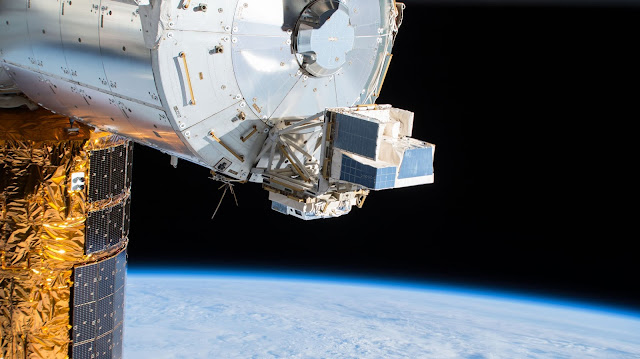ISS - Expedition 63 Mission patch.
July 17, 2020
Crew members aboard the International Space Station conducted research during the week of July 13 that included studies on imaging and measuring particles on the space station and improving diet and immune function. The crew also set up hardware for taking student-selected images of Earth.
Now in its 20th year of continuous human presence, the space station provides a platform for long-duration research in microgravity and for learning to live and work in space. NASA’s Commercial Crew Program, once again launching astronauts on American rockets and spacecraft from American soil, increases the crew time available for science on the orbiting lab.
Here are details on some of the microgravity investigations currently taking place:
Students take their shots
Image above: This Sally Ride EarthKAM image, one of the first from the July 2020 mission, shows Lake Disappointment in Western Australia. Image Credit: NASA.
The crew switched lenses for a Sally Ride Earth Knowledge Acquired by Middle Schools (EarthKAM) operation. Students control a special digital camera to take photographs of Earth’s features so they can examine them from the perspective of space. Hundreds of thousands of students have photographed coastlines, mountain ranges, and other geographic features, and the EarthKAM team posts these photographs on the Internet for viewing by the public and classrooms around the world. The first photos for EarthKAM mission 70 were posted online this week.
Patrolling for particles
Image above: View of the ESA Atmosphere-Space Interactions Monitor (ASIM) installed on the exterior of the space station. ASIM studies severe thunderstorms and their role in Earth’s atmosphere and climate. Image Credit: NASA.
During the week, the crew performed troubleshooting operations for the Mochii Microscope. Mochii is a miniature scanning electron microscope that conducts real-time imaging and measures the composition of particles on the space station. Particles can cause vehicle and equipment malfunctions and threaten crew health. Without the use of Mochii, samples must be returned to Earth for analysis. Not only does this requirement leave the crew and station at risk while waiting for results, but future deep space exploration missions will not have the option of sending samples back. In addition, Mochii provides a platform to support science and engineering applications, including planetary science on crewed and robotic missions.
A better diet for better health
Image above: NASA astronaut Chris Cassidy processes biological samples for the Food Physiology experiment, which examines the effects of an enhanced spaceflight diet on immune function, the gut microbiome, and nutrition. Image Credit: NASA.
The many effects of spaceflight on human physiology include changes to the immune system. Immune function is linked to diet, and the latter can be easily and meaningfully altered to improve the former. The Integrated Impact of Diet on Human Immune Response, the Gut Microbiota, and Nutritional Status During Adaptation to Spaceflight (Food Physiology) investigation documents the effects of dietary improvements on immune function and the gut microbiome and the ability of those improvements to support adaptation to spaceflight. With improved understanding of food’s effects on physiology, scientists can continue to improve the spaceflight diet and crew health. Crew members conducted briefings for the investigation during the week.
Other investigations on which the crew performed work:
- An ESA (European Space Agency) investigation, Acoustic Upgraded Diagnostics In-Orbit (Acoustic Diagnostics) assesses the possible adverse effects of noise and the microgravity environment by testing the hearing of crew members before, during, and after flight.
https://www.nasa.gov/mission_pages/station/research/experiments/explorer/Investigation.html?#id=7898
- The ESA (European Space Agency) Atmosphere-Space Interactions Monitor (ASIM) is an Earth observation facility studying severe thunderstorms and their role in Earth’s atmosphere and climate. Upper-atmospheric lightning phenomena occur well above the altitudes of normal lightning and storm clouds, and the space station’s low-Earth orbit provides an ideal platform for measuring them.
https://www.nasa.gov/mission_pages/station/research/experiments/explorer/Investigation.html?#id=1822
- Demonstration of JEM Water Recovery System (JWRS) from the Japan Aerospace Exploration Agency demonstrates a system for generating potable water from urine. Water could become a limiting factor on long-term space missions and this water recovery system contributes to updating the Environmental Control and Life Support System (ECLSS).
https://www.nasa.gov/mission_pages/station/research/experiments/explorer/Investigation.html?#id=2049
Space to Ground: Outside The Hatch: 07/17/2020
Related links:
Expedition 63: https://www.nasa.gov/mission_pages/station/expeditions/expedition63/index.html
NASA’s Commercial Crew Program: https://www.nasa.gov/exploration/commercial/crew/index.html
EarthKAM: https://www.nasa.gov/mission_pages/station/research/experiments/explorer/Investigation.html?#id=87
Food Physiology: https://www.nasa.gov/mission_pages/station/research/experiments/explorer/Investigation.html?#id=7870
Space Station Research and Technology: https://www.nasa.gov/mission_pages/station/research/overview.html
International Space Station (ISS): https://www.nasa.gov/mission_pages/station/main/index.html
Images (mentioned), Vdeo (NASA), Text, Credits: NASA/Michael Johnson/John Love, Lead Increment Scientist Expedition 63.
Best regards, Orbiter.ch




